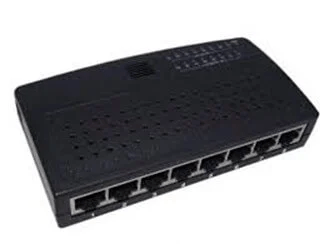
Hubs and switches have their uses in a computer network. However, they both have different mods of operation and produce different results. If you have a small network, you may only need a hub. However, with improved technology, switches are also available cheaply. In this article, you will learn to tell the difference between hub and switch to help you choose one.
Contents
What is a network hub?
A hub in computer networks is a networking device that operate at the Physical Layer of the OSI model and use electrical orbit signals to communicate. It is a common connection point for different computers to create a network.

Source: A Network Hub
Types of Network Hub
Two types of network hubs exist.
- Active Hub: These hubs have their power supply; they can clean, improve and relay the signal in the network. You can also use an active hub as a repeater or a writing centre. Using an active hub, you can also extend two or more nodes.
- Passive Hub: You don’t need a separate power supply to operate this type of hub. They get the power from another active hub or wiring node. They relay signals from the hubs to the network without cleaning and boosting. In addition, you cannot use them as an extension of nodes.
Features of Network Hubs
A hub has the following features that make it a helpful device in a network.
- It can broadcast data and share bandwidth.
- Hubs have one broadcast domain and one collision domain.
- In the OSI model, hubs operate at the Physical Layer.
- Using hubs, you can not create a virtual LAN.
- Hubs can transmit in a half-duplex mode.
- You can not span tree protocol using a hub.
Advantages and Disadvantages of a Hub
Advantages:
- HUB offers shared internet scalability. You can quickly extend a network using a hub with shared bandwidth.
- You use HUB for monitoring a network.
- HUBs are simple and can provide backward compatibility with older systems.
- You extend the total distance of a network using hubs.
- Hubs are not intelligent and are cheap.
Disadvantages:
- HUB provides only a half-duplex transmission mode, so you can only send signals in one direction at a time.
- You can not get dedicated bandwidth by connecting to a HUB.
- HUB does not offer a mechanism to select the best path for data transmission.
- You can not differentiate the devices connected to a HUB.
- A HUB only can create a small network.
- HUB cannot perform packet filtering. That means it cannot pass or block data packets depending on the source and destination addresses.
- HUBs only have very few ports, about 4-12.
- You cannot use HUB as a repeater.
What is a Network Switch?
A switch is a network device that establishes and terminates a connection based on the need. Switch operates on the Data Link layer and connects various devices on a single computer network. In addition, it can route information to the appropriate devices.

Source: A Network Switch
Types of Network Switches
The types of switches are
- Manageable Switches: You can manage these switches by setting and configuring IP addresses using the console port.
- Unmanageable Switches: You can not configure an unmanageable switch. It is not possible to assign IP addresses to the switch.
- LAN Switches: These switches allow connections to a company’s internal LAN and reduce bottlenecks.
- PoE Switches: These switches use power over ethernet technology to operate. They can support power and data transfer on one cable.
Features of a Switch
A switch is a Data Link device of the OSI model and works with a fixed bandwidth. It includes the following features.
- Maintaining a MAC address table to identifying the devices attached to the switch
- Creating a virtual LAN
- Working as a multiport bridge
- Having 24 to 48 ports to create an extensive computer network
Disadvantages and Advantages of Switches
Advantages of a Switch:
- Switches help reduce the size of broadcast domains; it will improve data transfer efficiency.
- You can construct a Virtual LAN using switches by logical segmentation of ports.
- Switches have a CAM table to store the MAC addresses of the devices connected. So it can route the data to the appropriate MAC address.
- Switches support broadcast, unicast, or multicast.
- You can use a switch as a repeater.
- Switches have a large number of ports, around 24-48.
- Switches perform packet filtering.
- Switches allow a full duplex; that means it can simultaneously handle single from both directions.
Disadvantages of a Switch:
- You cannot efficiently limit broadcasts using a switch.
- Communication between VLAN requires VLAN routing, not supported by a switch.
- Handling multicast packages using a switch requires lots of configuration and designing.
- Systems connected to hubs are more challenging to hack than those connected to a switch.
- Switches are expensive as they are intelligent, therefore, complex.
Difference Between a Network Hub and a Network Switch
Difference between a hub and a switch in networking based on specific characteristics.
| Network Hub | Network Switch | |
| Objective | Hubs transfer signals to the ports in response to the signal received | Network Switches can start or terminate connections as required |
| Layer | Hubs are at the physical layer of the OSI model | Switches are at the data link layer |
| Transmission Types | Hubs can only broadcast the signals | Switches can broadcast, multicast, or unicast |
|
Ports
| Hubs have only 4-12 ports and are only suitable for small networks | Network Switches have 24-48 ports and are suitable for more extensive networks |
| Collision Domain | Only one collision domain exists in a hub | Every port in a switch has a collision domain; this reduces the actual collision |
| Transmission modes | Hubs use half-duplex transmission mode | Switches use full-duplex transmission mode |
| Cost | Hubs are cheap because they are simple | Switches are intelligent and complex; hence they are costly |
| Types of Data | Hubs send electrical signal orbits | Switches send data frames |
| Spanning Tree | Hubs don’t offer implementation of spanning tree protocol | You can implement spanning trees using switches. Spanning trees are essential for path-finding algorithms |
| Memory | Hubs can’t store MAC addresses | Switches can store MAC addresses and can filter data accordingly |
FAQ
- In
what form does a Hub transmit data?
- A Hub transmits data in the form of binary bits of electrical signals. When the hub receives a data packet at one of the ports, it sends it as electrical signals to all the other ports. However, a switch transmits data in the form of data frames. A switch can examine the data frames, figure out the MAC address, and send them to the appropriate device.
- Do
Hubs have IP addresses?
- No Hub is not an intelligent device; it does not have an IP address. The devices communicating via a hub do not see the hub. Therefore, you can not assign an IP address to a hub. Hubs only take data from one port and send it to all the other ports through electrical signals. It doesn’t interpret the signals and cannot understand what it’s sending. And without understanding the contents of these signals, a device can not have an IP address.
- Which
layer of the OSI Model does a switch belong to?
- A switch belongs to the Data Link layer of the OSI or Open System Interconnection model. It can understand MAC addresses, so it doesn’t have to operate at a physical layer like a hub. But a switch does not understand IP addresses, so it can not be at the network layer. A switch only concerns MAC addresses and links data with the correct device.
- What
is the difference between a switch and a router?
- A router connects various networks, while a switch connects multiple devices in a network. They also operate at different OSI layers. A router is a network layer device; a switch in computer networks is a data link layer networking device. In a router, data packets collide less frequently than in a switch. Moreover, a router is NAT compatible, and a switch is not. The router is more expensive than a switch as the level of complexity increases in a router.















